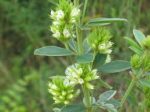 This herbaceous perennnial is a member of the pea family, Fabaceae, that also includes lupine, mimosa, and black locust. It is native to priaires, meadows, glades, and waste areas such as roadsides from New Brunswwick and South Dakota south to Florida and Texas. Growing from a taproot with long horizontal lateral roots, roundheaded bushclover is 2 t 4″ tall and has erect wiry stems with trifoliate leaves comprised 3-lobed narrow oblong leaflets up to 3″ long. Both stem and leaves are covered with white hairs. From July to September, axillary globular clusters of small creamy flowers with hairy bracts appear on the upper part of the stems. Each pea-like flower is up to 1/2″ long and has a magenta spot near its throat. Plants are drought tolerant, fix nitrogen in the soil and are valuable for soil building, erosion control, and livestock forage. The genus name, Lespedeza, honors the Spanish governor of Florida, Vincente Manuel de Cespedes c 1790, but a spelling mistake obscures the intent. The specific epithet, capitata, comes from the Latin word caput meaning head and refers to the dense head of flowers.
This herbaceous perennnial is a member of the pea family, Fabaceae, that also includes lupine, mimosa, and black locust. It is native to priaires, meadows, glades, and waste areas such as roadsides from New Brunswwick and South Dakota south to Florida and Texas. Growing from a taproot with long horizontal lateral roots, roundheaded bushclover is 2 t 4″ tall and has erect wiry stems with trifoliate leaves comprised 3-lobed narrow oblong leaflets up to 3″ long. Both stem and leaves are covered with white hairs. From July to September, axillary globular clusters of small creamy flowers with hairy bracts appear on the upper part of the stems. Each pea-like flower is up to 1/2″ long and has a magenta spot near its throat. Plants are drought tolerant, fix nitrogen in the soil and are valuable for soil building, erosion control, and livestock forage. The genus name, Lespedeza, honors the Spanish governor of Florida, Vincente Manuel de Cespedes c 1790, but a spelling mistake obscures the intent. The specific epithet, capitata, comes from the Latin word caput meaning head and refers to the dense head of flowers.
Type: Herbaceous perennial
Bloom: Axillary, globose clusters of small white flowers with magenta spot near the throat from July to September
Size: 2-4′ H x 1-2′ W
Light: Full sun to part shade
Soil: Average to lean, dry to medium moist, well-drained
Hardiness: Zones 4-8
Care: Low maintenance
Pests and Diseases: Rust, tar spot fungus, beetle Pachyschelus laevigatus
Propagation: Seed
Companion Plants: Not applicable
Outstanding Selections: ‘Kanoka’
Photo Credit: Wikimedia Commons